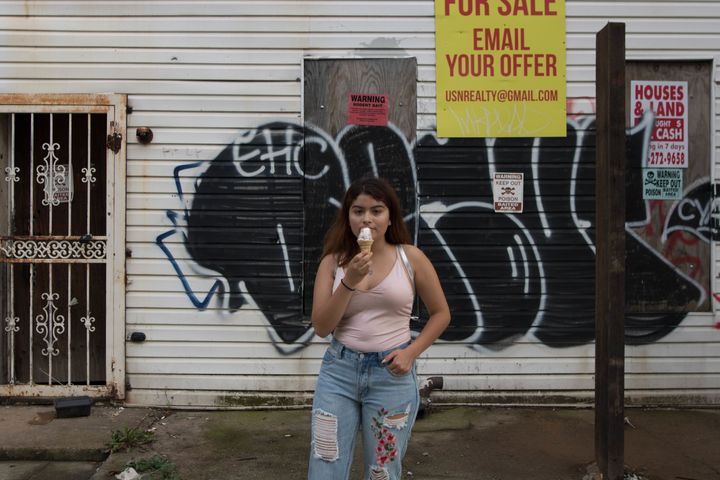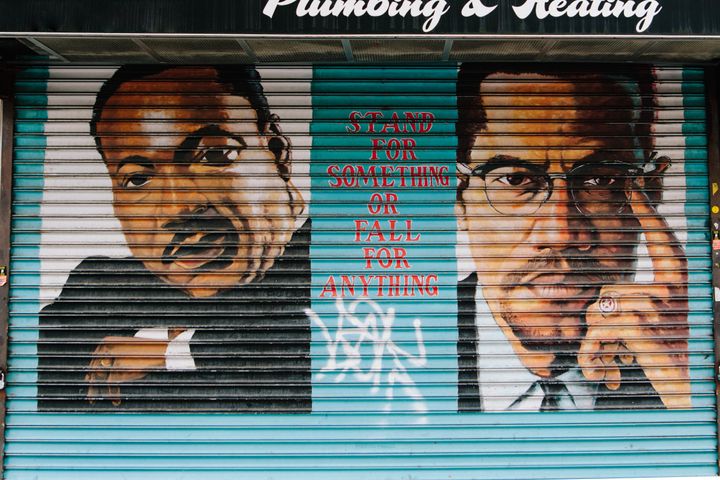I’ve always been one to pay attention to signs. Over the last week or so, the topic of gentrification has come up in many random moments. Last night, I was watching re-runs of the Jerrod Carmichael Show on Netflix, and I just happened to click on the episode “Gentrifying Bobby.”
In the episode, the question as to why gentrification was so bad was asked. The rest of the episode dove into the juxtaposed view of gentrification from the gentrifier and the gentrified.
The episode made me think. I even met up with a friend this week and she asked me: “I mean, what’s the problem with gentrification? When I leave for work at 4 a.m, I don’t want to be looking over my shoulder, as a woman, worrying about being harassed in the dark of night.”
Listening to my mind volley around the pros and cons of gentrification – now for years – I felt compelled to write about the topic through personal, anecdotal, and actual experiences I’ve had.
The Question:

It was mid-summer 2017. I was linking up with my company’s lawyer over drinks in the Northern Liberties area of Philadelphia. For those who are unaware, this is the most famously gentrified neighborhood in all of Philly. It went from a working class, downtrodden area in the 90s to home to some of the best brunch spots, craft beer stores, and new developments in the entire city in the 2000s.
There, he and I sat. The bar had a rustic and plant-based interior aesthetic. The design made you feel like you were sitting outside, although when you’d look in all four directions, it was clear you were inside a posh, new establishment. We tossed back a few beers, caught up on the business, and talked about life. A few topics in, the subject of my recent content videos came up. He thought we were speaking on issues he’d never really questioned or thought much about: redlining, public housing, the disparity in millennial wealth, etc.
After proclaiming how informative the videos were, he looked at me and asked: “At the risk of this being a stupid question and me sounding supremely ignorant, I must ask. And, you know me and where my heart is: What, really, is the problem with gentrification?"

To his surprise, I was humbled he’d felt close enough to me to ask such a real question. At that moment, I asked my 34-year-old, white, Jewish lawyer to look around the restaurant and tell me how many people he saw in there that looked like me – black. He glanced around and said “Oh wow. Just you and the server over there. Ah, I see.” I said, “There it is, the problem with gentrification. Once things get better, we're not allowed to stick around long enough to experience the change. Rent goes up, people of color move out.” Displacement.
Undeniable Good:
Keeping the convo I had with our lawyer in mind, let’s be real: Although "my people" weren’t necessarily benefiting from the newly gentrified neighborhood, we couldn’t deny the fact that we were sitting in a swanky restaurant sipping on local Philadelphia beers, unbothered. If we rewound to 1998 or the early 2000s, we were probably sitting where crimes had been committed, where there was tons of heartache. And, at the same time, we were probably sitting where a community center once stood, or a church, or an old elementary school – because, in Philly, schools seem to be the first to go when gentrification creeps in.
All that said, I’d be lying if I said no good came from gentrification. As a matter of fact, A LOT of good comes from it. That’s where things get so sticky. Crime goes down. NYC, which has experienced more displacement and gentrification than probably any American city in the last 20 years, has reached its lowest crime rate since the 1950s. The caliber of shops goes up. The police presence goes down. There are fewer food deserts and better food. Organic veggies. Farmers markets. Bakeries.

In 1969, my grandfather emigrated from Barbados to Bedstuy, Brooklyn. He bought a brownstone for $12,000 in the heart of the neighborhood. I remember when I would visit as a kid, I was told to not go past Lewis Avenue because it got real over there. For context, his brownstone wasn’t more than five minutes away from the infamous Marcy or Tompkins Projects.
In May 2013, I moved from Philly, where I’d just graduated from Temple University, and relocated to Bedstuy, Brooklyn. I rented out the top floor from my grandpops. FYI, a quick Zillow search at that time revealed that the cheapest home on the block was worth $800K. Talk about rising home values. In the four-and-a-half years I’ve lived there (while still satelliting to Philly many weeks), I’ve seen the neighborhood change in front of my eyes.
When I first got there, white folks got off the train at Nostrand Ave (which was already pretty crazy in itself). Two years later, they were getting off after my stop. I’d look around like, “Where are you going?” The neighborhood changed. Laundromats and Kennedy Fried Chickens closed up and ritzy, gourmet pizza spots, cafes, and local bars moved in. Our community garden went from being aight in presentation to becoming the beautiful gem of the block. At the end of last summer, they were even offering a day of FREE yoga, acupuncture, massages, food, and Reiki sessions. It was amazing. And my black friends and I were right over there indulging in the free activities. Can’t deny it…

Undeniable Bad:
I referred to it before. It’s called displacement. Policies are put in place. Proclamations are made by private business owners to hire within the community, etc. I primarily grew up in Baltimore and then Ellicott City, Md. I saw Baltimore while it was in its worst state in the 90s and I saw it as it got a teeny bit better in the early 2000s (I mean it’s still pretty rough). But what I’ve also witnessed is the commitment to reinvigorate the area, mostly fueled by Kevin Plank, the CEO of Under Armour, and his desire to rebuild the city that helped spur the creation of one of the most recognizable sports brands on the planet.
This winter, when I returned home for Thanksgiving, I reconnected with a bunch of my Maryland friends – many of whom now lived in the Canton and Fed Hill areas of Baltimore. For those unaware of how Ellicott City compares, it’s a far cry from Baltimore. It’s a middle to upper-middle-class suburb between Baltimore and DC known for its school system, diversity, and low crime rates. There are domestic disputes and drinking and driving, and that’s mostly it (obviously not, but you know what I mean). The average Howard County cop was making three times what a Baltimore City cop made. It’s just how it was and still is. Taxes. Zip codes.

I bring this up because when I went down to Baltimore to catch up with my high school friends, it felt different this time around. I invited my siblings to join me and my friends so we could paint the town red together. What was so trippy was that many of the new establishments — hotels, bars, restaurants — were owned by Kevin Plank. The bartenders even wore Under Armour shirts. And I knew by looking around, as part of this urban renewal effort, hiring from within the community was more than likely stated to be one of their goals. But the more I looked around, all I saw was white with a few pepper and cinnamon dots sprinkled in. And, just as alarming, I felt like I knew half the room, no matter where I went.
Here I was, in 2017, in the middle of a city that many from the suburbs I grew up in would verbally poop on any chance they got – and, now, they all lived there. Instead of the community members now having access to these new amenities and locations, these suburban kids, whose parents owned land, owned property, were now renting and buying homes in Baltimore. This was a lateral move, a widening of the suburban footprint, not an authentic investment in the growth of the urban one.
My Thoughts:
As you’ll hear me say often, there are many Truths in every situation. Understanding this, I can say that if we’re looking at the way we’re doing it today, gentrification is mostly bad. Landlords are not adequately punished for shady practices of locking residents out, hiking rents beyond their legal limits, or engaging in excessively litigious practices to make current residents’ lives uncomfortable (in hopes to pave the way for richer, more well off, and often whiter renters). Politicians aren’t taken to task for their developer-friendly annual budgets, their lax enforcement of laws in place to curb excessive displacement, and their consistent inability to put the needs of the communities they serve ahead of the desires of the developers in their pockets.

The view of gentrification can and must change. And I’m hopeful that, with more worldly millennials and Gen Z folks, in the midst of it all, they will look into questioning their surroundings more and challenge their cities to more appropriately address the issues at hand.
At its core, gentrification should be about the meshing of many cultures at once. But this isn’t often what happens. Realize, when you’re moving into a new community, you’re doing just that, moving into another, already established community. So, even if you don’t value the language of their street — their culture, their rhythm — understand, your opinion matters second to the folks who’ve lived in and endured those environments long before you got there.

It’s up to us to challenge the forces at play that disrupt these neighborhoods with no regard for the artistic aesthetic of the community or any understanding of the interpersonal fibers that tie it together. As a well-respected NYC developer, worth $700M, recently said at an event: “I’m not funding politicians’ campaigns because I’m a fan of their ideology. I’m buying my seat at the table.” And you know what, that’s real. That’s precisely why the only thing that’ll make us more aware of our damaging approach to the revitalization of cities is our commitment to speaking about and acting on the topic; by realizing, in our day to day life, how WE can contribute to the COMMUNITY, not just take from it.
*This is merely an article and each component highlighted is essential enough to warrant a book or myriad of books. For those with more to add, I urge you to use this as a jumping off point. Learn more, listen more, connect more. Hopefully, next time the topic of gentrification comes up amongst your peers, this article can help provide some insight from varying vantage points. Cheers to Growth.
---------------------------
About the Author
Ofo Ezeugwu is co-founder and CEO of WYL, a platform empowering and informing the rental community through landlord reviews, community focused content, and by providing access to quality listings. He’s been featured on the Today Show (7x) and ESPN (2x), walked in NYFW (3x), is one of BET’s #30Under30, is a Black Enterprise: Modern Man, and his work has been featured in Newsweek, MSNBC, TechCrunch, The San Francisco Chronicle, The Philadelphia Inquirer & more. He’s also spoken on tech - entrepreneurship - and investment at prestigious institutions such as The White House, Harvard, Princeton, Columbia, Wharton, Temple, Villanova, etc.
For more info, follow him on Twitter @OfoEzeugwu (same handle for IG) and review your landlord on whoseyourlandlord.com.
